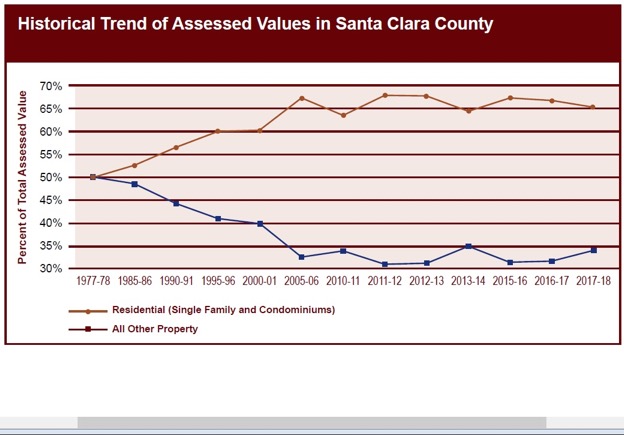Silicon Valley property values grew solidly in 2017—7.4 percent, $31 million, over 2016—Santa Clara County Assessor Larry Stone reports in the agency’s annual report.
But Silicon Valley’s longtime guru of land use notes a slowdown of the growth in local property value. “This is the second longest post-recession recovery in our history,” said Stone. “To expect this to continue doesn’t make sense. We hope it will have a soft landing, but it [a downturn] will happen.”
One of the signs Stone sees is a decline in the pre-leasing of new office space. “Until 2017, 70 to 80 percent of all new office space was leased prior to construction,” he said. “Now that number is 48 percent.”
However, Stone says that the commercial real estate environment is very different from the dot-com boom and subsequent bust of the late 1990s and early 2000s. “At that time the market was largely startups who leased more space than they needed, expecting growth that never occurred.
“Today,” he continued, “it’s Apple, NVIDIA, Facebook, Google—large established companies with real earnings. And they’re buying land and building new buildings.”
City Property Value Growth Stays High, Affordable Housing Stays Low
Santa Clara’s property value growth was slightly under 10 percent, second only to Mountain View’s 11 percent growth. Both Cupertino and Sunnyvale saw slightly above 8 percent growth, while San José saw 6 percent growth.
Santa Clara was also a leader for major new construction in 2017, with 50 percent of the County’s 10 biggest projects in the City. Eight of the County’s 25 companies with the highest property value*—including four of the top 10—are also located in Santa Clara.
However, Santa Clara doesn’t make the top of the list—or even come close—when it comes to affordable apartments. Excluding the County’s largest city, San José, and cities with no affordable apartments—Los Altos, Los Altos Hills, Monte Sereno and Saratoga—Santa Clara, with its population of 123,000, is fourth from the bottom with 894 units.
By contrast Palo Alto, population 69,000, tops the list with 1,436 affordable apartments. Mountain View, population 79,000, is second with 1,304 units while Sunnyvale, population 149,000, comes in third with 1,268.
40 Years On, Homeowners are Prop 13’s Losers
Despite all the shiny new office campuses that have sprouted recently in Silicon Valley, thanks to the continuing legacy of Prop 13’s pegging assessments at property’s purchase price homeowners now carry 65 percent of the county tax burden, according to the Assessor’s report.
When the property tax-capping law went into effect in 1979 the Santa Clara County property tax burden—based on assessed property values—was evenly split between commercial and residential property. Today, almost 40 years later, homeowners shoulder 65 percent of the property tax burden while commercial property owners’ share has dropped to only 35 percent.
The reason for this is that commercial property owners have many avenues—mergers, equity buyouts, complex ownership structures—for avoiding changes in ownership that would trigger new assessments.
Twenty-two percent of business properties are assessed at pre-1998 values, compared with 19 percent of homes. Eight percent of commercial property is assessed at 1975 values, compared with 2 percent of homes.
“We gave the [tax] benefit to businesses as well as homeowners,” Stone said. Businesses weren’t suffering the hardships homeowners faced with rapidly rising property tax bills as Silicon Valley real estate values began to skyrocket in the 1970s. Howard Jarvis, Prop 13’s mastermind, was a lobbyist for the Los Angeles Apartment Association.
Stone is passionate in his call to reform Prop 13. He calls the law’s impact “insidious” and characterizes the fact that under Prop 13 people can own identical houses but have wildly different tax bills as ‘un-American.’ “When they call 9-1-1 they get the same police service, they use the same roads. Yet one owner is paying many times more for those same services.
“You couldn’t devise a more unfair property tax system if you tried,” he continued. “It punishes young people. [California] home ownership is at its lowest level since 1967.”
Several public interest groups have joined together to move forward a 2018 ballot measure to create a “split roll”—keep Prop 13 protections for homeowners but allow commercial property tax to be assessed at current values, rather than the purchase price. Stone says he’s optimistic. “I believe they’re serious and intend to proceed with a ballot measure.”
In 2010 the California Tax Reform Association did an exhaustive study of Prop 13’s tax-shifting impact and California’s commercial property tax-avoidance loopholes: tinyurl.com/caltaxreform-2010rpt.
*Commercial property value includes both the value of real estate and the value of business furnishings and improvements.






